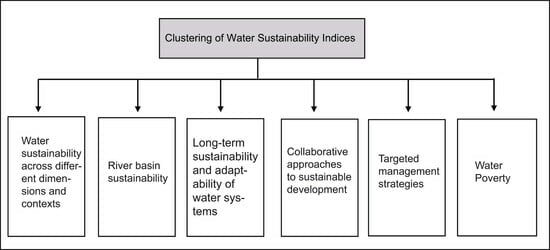Comparative Analysis of Water Sustainability Indices: A Systematic Review
Abstract
1. Introduction
2. Materials and Methods
2.1. Eligibility Criteria
2.2. Information Sources
2.3. Search
2.4. Study Selection
2.5. Data Items
2.6. Data Collection
2.7. Synthesis of the Results
3. Results
3.1. Study Selection
3.2. Biometric Network Analysis
4. Discussion
4.1. Publication Groups Based on Keywords and SDGs Addressed
4.2. Domains for Holistic Sustainable Development
4.3. Indicator Systems and Applications
4.4. Indicator Applications for Sustainability
4.5. Six Clusters of Water Sustainability Indices
4.6. The Common “Sustainability Index” Represents Different Nature Water Indices
4.7. Suggestions for Future Water Sustainability Indices Studies
5. Conclusions
Supplementary Materials
Author Contributions
Funding
Data Availability Statement
Conflicts of Interest
References
- Beck, M.B. Cities as Forces for Good in the Environment: Sustainability in the Water Sector; Warnell School of Forestry & Natural Resources, University of Georgia: Athens, GA, USA, 2011; Available online: http://cfgnet.org/archives/587 (accessed on 20 June 2023).
- Werkheiser, I.; Piso, Z. People Work to Sustain Systems: A Framework for Understanding Sustainability. J. Water Resour. Plan. Manag. 2015, 141, A4015002. [Google Scholar] [CrossRef]
- Best, J. Anthropogenic stresses on the world’s big rivers. Nat. Geosci. 2019, 12, 7–21. [Google Scholar] [CrossRef]
- OECD POLICY HIGHLIGHTS Diffuse Pollution, Degraded Waters: Emerging Policy Solutions. OECD Policy Highlights. 2017. Available online: https://www.oecd.org/environment/resources/Diffuse-Pollution-Degraded-Waters-Policy-Highlights.pdf (accessed on 11 July 2023).
- Keeler, B.L.; Polasky, S.; Brauman, K.A.; Johnson, K.A.; Finlay, J.C.; O’Neille, A.; Kovacs, K.; Dalzell, B. Linking water quality and well-being for improved assessment and valuation of ecosystem services. Proc. Natl. Acad. Sci. USA 2012, 109, 18619–18624. [Google Scholar] [CrossRef]
- Rockström, J.; Falkenmark, M.; Allan, T.; Folke, C.; Gordon, L.; Jägerskog, A.; Kummu, M.; Lannerstad, M.; Meybeck, M.; Molden, D.; et al. The unfolding water drama in the Anthropocene: Towards a resilience-based perspective on water for global sustainability. Ecohydrology 2014, 7, 1249. [Google Scholar] [CrossRef]
- Feng, Y.; Zheng, B.-H.; Jia, H.-F.; Peng, J.-Y.; Zhou, X.-Y. Influence of social and economic development on water quality in Dongting Lake. Ecol. Indic. 2021, 131, 108220. [Google Scholar] [CrossRef]
- Barman, P.; Ghosh, J.; Deb, S. Study of water quality, socio-economic status and policy intervention in spring ecosystems of Tripura, Northeast India. Discov. Water 2022, 2, 7. [Google Scholar] [CrossRef]
- Progress on Household Drinking Water, Sanitation and Hygiene 2000–2020: Five Years into the SDGs. World Health Organization (WHO) and the United Nations Children’s Fund (UNICEF). 2021. Available online: https://washdata.org/sites/default/files/2021-07/jmp-2021-wash-households.pdf (accessed on 12 June 2023).
- The United Nations World Water Development Report 2015: Water for a Sustainable World; United Nations World Water Assessment Programme; UNESCO; Paris, France, 2015; Available online: https://unesdoc.unesco.org/ark:/48223/pf0000231823 (accessed on 26 June 2023).
- Transforming Our World: The 2030 Agenda for Sustainable Development; United Nations: New York, NY, USA, 2015; Available online: https://sustainabledevelopment.un.org/post2015/transformingourworld (accessed on 26 June 2023).
- Pradhan, P.; Costa, L.; Rybski, D.; Lucht, W.; Kropp, J.P. A Systematic Study of Sustainable Development Goal (SDG) Interactions. Earth’s Future 2017, 5, 1169–1179. [Google Scholar] [CrossRef]
- Requejo-Castro, D.; Giné-Garriga, R.; Pérez-Foguet, A. Data-driven Bayesian network modelling to explore the relationships between SDG 6 and the 2030 Agenda. Sci. Total Environ. 2020, 710, 136014. [Google Scholar] [CrossRef]
- Bhaduri, A.; Bogardi, J.; Siddiqi, A.; Voigt, H.; Vörösmarty, C.; Pahl-Wostl, C.; Bunn, S.E.; Shrivastava, P.; Lawford, R.; Foster, S.; et al. Achieving sustainable development goals from a water perspective. Front. Environ. Sci. 2016, 4, 64. [Google Scholar] [CrossRef]
- da Silva, J.; Fernandes, V.; Limont, M.; Dziedzic, M.; Andreoli, C.V.; Rauen, W.B. Water sustainability assessment from the perspective of sustainable development capitals: Conceptual model and index based on literature review. J. Environ. Manag. 2020, 254, 109750. [Google Scholar] [CrossRef]
- Morris, J. Developing and exploring indicators of water sustainable development. Heliyon 2019, 5, e01778. [Google Scholar] [CrossRef]
- Saikia, P.; Beane, G.; Garriga, R.G.; Avello, P.; Ellis, L.; Fisher, S.; Leten, J.; Ruiz-Apilánez, I.; Shouler, M.; Ward, R.; et al. City Water Resilience Framework: A governance based planning tool to enhance urban water resilience. Sustain. Cities Soc. 2020, 77, 103497. [Google Scholar] [CrossRef]
- Mishra, B.K.; Kumar, P.; Saraswat, C.; Chakraborty, S.; Gautam, A. Water Security in a Changing Environment: Concept, Challenges and Solutions. Water 2021, 13, 490. [Google Scholar] [CrossRef]
- Vollmer, D.; Regan, H.M.; Andelman, S.J. Assessing the sustainability of freshwater systems: A critical review of composite indicators. Ambio 2016, 45, 765–780. [Google Scholar] [CrossRef]
- Waas, T.; Hugé, J.; Block, T.; Wright, T.; Benitez-Capistros, F.; Verbruggen, A. Sustainability Assessment and Indicators: Tools in a Decision-Making Strategy for Sustainable Development. Sustainability 2016, 6, 5512–5534. [Google Scholar] [CrossRef]
- Karthe, D.; Bogardi, J.; Borchardt, D. Water resources management: Integrated and adaptive decision making. In Handbook of Water Resources Management: Discourses, Concepts and Examples; Bogardi, J.J., Tingsanchali, T., Nandalal, K.D.W., Gupta, J., Salamé, L., van Nooijen, R.R.P., Kolechkina, A.G., Kumar, N., Bhaduri, A., Eds.; Springer: Cham, Switzerland, 2021; pp. 365–381. [Google Scholar] [CrossRef]
- Jiménez, A.; Saikia, P.; Giné, R.; Avello, P.; Leten, J.; Lymer, B.L.; Schneider, K.; Ward, R. Unpacking Water Governance: A Framework for Practitioners. Water 2020, 12, 827. [Google Scholar] [CrossRef]
- Panda, R.K.; Sahu, R.; Padhi, J. Evaluation of Water Sustainability Index for sustainable water resources management in India. J. Water Resour. Plan. Manag. 2017, 143, 04017004. [Google Scholar]
- Juwana, I.; Muttil, N.; Perera, B.J. Indicator-based water sustainability assessment—A review. Sci. Total Environ. 2012, 438, 357–371. [Google Scholar] [CrossRef]
- Dizdaroglu, D. The Role of Indicator-Based Sustainability Assessment in Policy and the Decision-Making Process: A Review and Outlook. Sustainability 2017, 9, 1018. [Google Scholar] [CrossRef]
- When, U.; Collins, K.; Anema, K.; Basco-Carrera, L.; Lerebours, A. Stakeholder engagement in water governance as social learning: Lessons from practice. Water Int. 2018, 43, 34–59. [Google Scholar] [CrossRef]
- Loucks, D.P. Quantifying trends in system sustainability. Hydrol. Sci. J. 1997, 42, 513–530. [Google Scholar] [CrossRef]
- Loucks, D.P.; van Beek, E. Water Resources Systems Planning and Management; United Nations Educational, Scientific and Cultural Organization (UNESCO): Paris, France, 2005. [Google Scholar]
- Page, M.J.; Moher, D.; Bossuyt, P.M.; Boutron, I.; Hoffmann, T.C.; Mulrow, C.D.; Shamseer, L.; Tetzlaff, J.M.; Akl, E.A.; Brennan, S.E.; et al. PRISMA 2020 explanation and elaboration: Updated guidance and exemplars for reporting systematic reviews. BMJ 2021, 372, 160. [Google Scholar] [CrossRef]
- Bwire, C.; Mohan, G.; Karthe, D.; Caucci, S.; Pu, J. A Systematic Review of Methodological Tools for Evaluating the Water, Energy, Food, and One Health Nexus in Transboundary Water Basins. Environ. Manag. 2023, 72, 598–613. [Google Scholar] [CrossRef]
- Jarzebski, M.P.; Ahmed, A.; Boafo, Y.A.; Balde, B.S.; Chinangwa, L.; Saito, O.; von Maltitz, G.; Gasparatos, A. Food security impacts of industrial crop production in sub-Saharan Africa: A systematic review of the impact mechanisms. Food Secur. 2020, 12, 105–135. [Google Scholar] [CrossRef]
- Xu, S.; Qiao, X.; Zhu, L.; Zhang, Y.; Xue, C.; Li, L. Reviews on determining the number of clusters. Appl. Math. Inf. Sci. 2016, 10, 1493–1512. [Google Scholar] [CrossRef]
- Cook, D.J.; Mulrow, C.D.; Haynes, R.B. Systematic reviews: Synthesis of best evidence for clinical decisions. Ann. Intern. Med. 1997, 126, 376–380. [Google Scholar] [CrossRef]
- Jarzebski, M.P.; Kudo, S. The ecological domain in sustainability science research and education. Ecol. Quest. 2016, 24, 65–74. [Google Scholar] [CrossRef]
- United Nations. Goal 6: Ensure Access to Water and Sanitation for All. Available online: https://www.un.org/sustainabledevelopment/water-and-sanitation/ (accessed on 7 March 2024).
- United Nations. SDG 14: Life Below Water. Available online: https://www.globalgoals.org/goals/14-life-below-water/ (accessed on 7 March 2024).
- Elfithri, R.; Mokhtar, M.; Abdullah, M.P.; Taha, M.R.; Toriman, M.E.; Yasin, R.M.; Yaakub, J.; Khirotdin, R.P.K.; Sultan, M.M.A.; Ishak, S.A.; et al. Watershed Sustainability Index for Langat UNESCO HELP River Basin, Malaysia. Int. J. Eng. Technol. 2018, 7, 187–190. [Google Scholar] [CrossRef]
- da Silva, J.C.C.; Lima, A.M.M.d.; Holanda, B.S.d.; Moreira, F.d.S.d.A.; Cavalcante, J.d.C. Sustainability index in the municipal district of the Marapanim river watershed (Pará/Brazil). Rev. Gest. Ambient. Sustentabilidade 2021, 10, 1–23. [Google Scholar] [CrossRef]
- Juwana, I.; Perera, B.J.C.; Muttil, N. A water sustainability index for West Java. Part 1: Developing the conceptual framework. Water Sci. Technol. 2010, 62, 1629–1640. [Google Scholar] [CrossRef]
- Juwana, I.; Muttil, N.; Perera, C. West Java Water Sustainability Index–A case study on Citarum Catchment. In Proceedings of the MODSIM2011, 19th International Congress on Modelling and Simulation, Perth, Australia, 12–16 December 2011; pp. 2184–2190. [Google Scholar] [CrossRef]
- Odjegba, E.; Oluwasanya, G.; Idowu, O.; Shittu, O.; Brion, G. Sustainability Indices and Risk Analysis of Drinking Water Systems in Southwest Nigeria. J. Water Supply Res. Technol.-AQUA 2020, 69, 591–603. [Google Scholar] [CrossRef]
- Al-Mohammed, F.M. Evaluation the Canadian Water Sustainability Index in Ain Al-Tamr district/Kerbala-Iraq. In Proceedings of the 1st International Conference on Achieving the Sustainable Development Goals, Istanbul, Turkey, 6–7 June 2022; Volume 2776. [Google Scholar] [CrossRef]
- Attari, J.; Mojahedi, S.A.; Sarraf, A. Assessing of Canadian water sustainability index (CWSI) in ahwaz county located in south west of Iran. J. Biodivers. Environ. Sci. 2014, 5, 183–194. [Google Scholar]
- Hirai, M.; Cole, A.; Munyaka, M.; Mudhuviwa, S.; Maja, T.; Cronin, A. Use of group maturity index to measure growth, performance, and sustainability of community health clubs in urban water, sanitation and hygiene (Wash) program in Zimbabwe. J. Water Sanit. Hyg. Dev. 2020, 10, 1026–1033. [Google Scholar] [CrossRef]
- Khan, M.I.; Saddique, Q.; Zhu, X.; Ali, S.; Ajaz, A.; Zaman, M.; Saddique, N.; Buttar, N.A.; Arshad, R.H.; Sarwar, A. Establishment of Crop Water Stress Index for Sustainable Wheat Production under Climate Change in a Semi-Arid Region of Pakistan. Atmosphere 2022, 13, 2008. [Google Scholar] [CrossRef]
- Cai, J.; Zhao, D.; Varis, O. Match words with deeds: Curbing water risk with the Sustainable Development Goal 6 index. J. Clean. Prod. 2021, 318, 128509. [Google Scholar] [CrossRef]
- Sandoval-Solis, S.; McKinney, D.C.; Loucks, D.P. Sustainability index for water resources planning and management. J. Water Resour. Plan. Manag. 2011, 137, 381–390. [Google Scholar] [CrossRef]
- De Carvalho, S.C.P.; Carden, K.J.; Armitage, N.P. Application of a sustainability index for integrated urban water management in Southern African cities: Case study comparison-Maputo and Hermanus. Water SA 2009, 35, 18–22. [Google Scholar] [CrossRef]
- Azmanajaya, E.; Paulus, C.A.; Paranoan, N. The Sustainability index of the provision of clean water treatment plants (IPAB) in supporting SDG 2030 programs for the availability and management of sustainable clean water in Soppeng Regency, South Sulawesi Province, Indonesia. J. Phys. Conf. Ser. 2020, 1464, 012052. [Google Scholar] [CrossRef]
- Srdjevic, Z.; Srdjevic, B. An Extension of the Sustainability Index Definition in Water Resources Planning and Management. Water Resour. Manag. 2017, 31, 1695–1712. [Google Scholar] [CrossRef]
- Malkina-Pykh, I.G.; Pykh, Y.A. Indices and indicators of water sustainability: Systems analysis approach. WIT Trans. Ecol. Environ. 2001, 46, 10. [Google Scholar]
- Arcoverde, G.F.B.; Menezes, J.A.; Paz, M.G.A.; Barros, J.D.; Guidolini, J.F.; Branco, E.A.; de Andrade, P.R.; Pulice, S.M.P.; Ometto, J.P.H.B. Sustainability assessment of Cerrado and Caatinga biomes in Brazil: A proposal for collaborative index construction in the context of the 2030 Agenda and the Water-Energy-Food Nexus. Front. Phys. 2023, 10, 1060182. [Google Scholar] [CrossRef]
- Gal, G.; Zohary, T. Development and application of a sustainability index for a lake ecosystem. Hydrobiologia 2017, 800, 207–223. [Google Scholar] [CrossRef]
- Sudha, M.C.; Ravichandran, S.; Sakthivadivel, R. Water Bodies Protection Index for assessing the sustainability status of lakes under the influence of urbanization: A case study of south Chennai, India. Environ. Dev. Sustain. 2013, 15, 1157–1171. [Google Scholar] [CrossRef]
- Naubi, I.; Zardari, N.H.; Shirazi, S.M.; Roslan, N.A.; Yusop, Z.; Haniffah, M.R.B.M. Ranking of Skudai river sub-watersheds from sustainability indices-Application of promethee method. GEOMATE J. 2017, 12, 124–131. [Google Scholar] [CrossRef]
- Leones, J.L.; Restrepo, J.F.; Velandia, K.; Sanchez, E.; Ojeda, K.A. Sustainability Assessment of Water Ecosystems based on Modified Water Poverty Index (WPI) with Birds’ Biodiversity Parameters. Case study: Juan Angola Creek-Cartagena, Colombia. Chem. Eng. Trans. 2023, 98, 147–152. [Google Scholar] [CrossRef]
- Najar, N.; Persson, K.M. A Sustainability Index within Water and Wastewater Management in Sweden: An Evaluation of Eight Case Studies. Water 2021, 13, 1879. [Google Scholar] [CrossRef]
- Sodhi, M.S.; Yatskovskaya, E. Developing a sustainability index for companies’ efforts on responsible use of water. Int. J. Prod. Perform. Manag. 2014, 63, 800–821. [Google Scholar] [CrossRef]
- Kumar, R.R.; Kumar, G.; Gupta, R. Assessment of sustainability index for rural water management using ANN. Water Suppl. 2022, 22, 1421–1433. [Google Scholar] [CrossRef]
- Benassai, G.; Stenberg, C.; Christoffersen, M.; Mariani, P. A Sustainability Index For Offshore Wind Farms and Open Water Aquaculture. WIT Trans. Ecol. Environ. 2011, 149, 3–14. [Google Scholar] [CrossRef]
- Hernández-Bedolla, J.; Solera, A.; Paredes-Arquiola, J.; Pedro-Monzonís, M.; Andreu, J.; Sánchez-Quispe, T.S. The Assessment of Sustainability Indexes and Climate Change Impacts on Integrated Water Resource Management. Water 2017, 9, 213. [Google Scholar] [CrossRef]
- Maynard, I.F.N.; Cruz, M.A.S.; Gomes, L.J. Applying a sustainability index to the Japaratuba river wathershed in Sergipe state. AMB Soc. 2017, 20, 201–220. [Google Scholar] [CrossRef][Green Version]
- Mititelu-Ionuş, O. Watershed sustainability index development and application: Case study of the Motru river in Romania. Pol. J. Environ. Stud. 2017, 26, 2095–2105. [Google Scholar] [CrossRef]
- Juwana, I.; Perera, B.J.C.; Juwana, I.; Muttil, N. Conceptual framework for the development of West Java water sustainability index. In Proceedings of the 18th World IMACS/MODSIM Congress, Cairns, Australia, 13–17 July 2009; pp. 3343–3349. [Google Scholar]
- Juwana, I.; Muttil, N.; Perera, B.J.C. Uncertainty and sensitivity analysis of West Java Water Sustainability Index—A case study on Citarum catchment in Indonesia. Ecol. Indic. 2016, 61, 170–178. [Google Scholar] [CrossRef]
- Juwana, I.; Perera, B.J.C.; Muttil, N. A water sustainability index for West Java. Part 2: Refining the conceptual framework using Delphi technique. Water Sci. Technol. 2010, 62, 1641–1652. [Google Scholar] [CrossRef]
- Jahanshahi, S.; Kerachian, R. An evidential reasoning-based sustainability index for water resources management. Hydrol. Sci. J. 2019, 64, 1223–1239. [Google Scholar] [CrossRef]
- de Castro Pardo, M.; Martín Martín, J.M.; Guaita Martínez, J.M.; Ribeiro Soriano, D.E. A fuzzy-DEA water sustainability index: An application in European Union water risk hotspots. Environ. Dev. Sustain. 2023. [Google Scholar] [CrossRef]
- Biswas, J.K.; Mondal, B.; Priyadarshini, P.; Abhilash, P.C.; Biswas, S.; Bhatnagar, A. Formulation of Water Sustainability Index for India as a performance gauge for realizing the United Nations Sustainable Development Goal 6. Ambio 2022, 51, 1569–1587. [Google Scholar] [CrossRef]
- Zamanzad-Ghavidel, S.; Sobhani, R.; Etaei, S.; Hosseini, Z.; Montaseri, M. Development of hydro-social-economic-environmental sustainability index (HSEESI) in integrated water resources management. Environ. Monit. Assess. 2021, 193. [Google Scholar] [CrossRef]
- Alvarado, C.; Velasco, S.; Leones-Cerpa, J.; Sánchez-Tuirán, E.; Ojeda, K.A. Socioeconomic and Environmental Analysis Based on Water Sustainability Index in the Juan Angola Creek (Cartagena, Colombia). Chem. Eng. Trans. 2023, 98, 153–158. [Google Scholar] [CrossRef]
- de Castro-Pardo, M.; Cabello, J.M.; Martín, J.M.; Ruiz, F. A multi reference point based index to assess and monitor European water policies from a sustainability approach. Socio-Econ. Plann. Sci. 2022, 89, 101433. [Google Scholar] [CrossRef]
- Zamanzad-Ghavidel, S.; Bozorg-Haddad, O.; Goharian, E. Sustainability assessment of water resource systems using a novel hydro-socio-economic index (HSEI). Environ. Dev. Sustain. 2021, 23, 1869–1916. [Google Scholar] [CrossRef]
- Kang, M.G.; Kim, J.K.; Lee, G.M. Assessment of water resources sustainability at a watershed using integrated index. In Proceedings of the 31st IAHR Congress 2005: Water Engineering for the Future, Choices and Challenges, Seoul, Republic of Korea, 11–16 September 2005; pp. 4515–4524. [Google Scholar]
- da Silva, D.C.; Oliveira, R.A.; Simonetti, V.C.; Toniolo, B.P.; Sales, J.C.A.; Lourenço, R.W. Creation of an environmental sustainability index for water resources applied to watersheds. Environ. Dev. Sustain. 2022, 25, 11285–11305. [Google Scholar] [CrossRef]
- Abdi-Dehkordi, M.; Bozorg-Haddad, O.; Chu, X. Development of a Combined Index to Evaluate Sustainability of Water Resources Systems. Water Resour. Manag. 2021, 35, 2965–2985. [Google Scholar] [CrossRef]
- Mvongo, V.D.; Defo, C.; Tchoffo, M. Application of the Water Service Sustainability Index to water services in sub-Saharan Africa: The case studies of eight councils in the Southern region of Cameroon (Central Africa). J. Water Sanit. Hyg. Dev. 2022, 12, 168–185. [Google Scholar] [CrossRef]
- Crispim, D.L.; Fernandes, L.L. Application of the Rural Water Sustainability Index (RWSI) in Amazon rural communities, Pará, Brazil. Water Policy 2022, 24, 282–304. [Google Scholar] [CrossRef]
- Mvongo, V.D.; Defo, C.; Tchoffo, M. Sustainability of rural water services in rural Sub-Saharan Africa environments: Developing a Water Service Sustainability Index. Sustainable Water Resour. Manag. 2021, 7, 46. [Google Scholar] [CrossRef]
- Vieira, E.d.O.; Sandoval-Solis, S. Water resources sustainability index for a water-stressed basin in Brazil. J. Hydrol. Reg. Stud. 2018, 19, 97–109. [Google Scholar] [CrossRef]
- Duarte, A.A.L.S.; Rodrigues, G.M.C.; Ramos, A.R.R. A global service quality index to evaluate the performance and sustainability in water supply utilities. WSEAS Trans. Environ. Dev. 2009, 5, 759–769. [Google Scholar]
- Cánovas-Molina, A.; García-Frapolli, E.; Ruggerio, C.A. A proposal of an Irrigation Sustainability Index for agricultural basins: Application in a semi-arid river basin. Irrig. Sci. 2023, 41, 173–182. [Google Scholar] [CrossRef]
- Mvongo, V.D.; Defo, C.; Tchoffo, M. Uncertainty and sensitivity analysis of Water Service Sustainability Index. Sustain. Water Resour. Manag. 2023, 9, 31. [Google Scholar] [CrossRef]
- Bi, J. New water quality indices for the era of sustainable development in China. GeoJournal 1996, 40, 9–15. [Google Scholar] [CrossRef]
- Finco, A.; Bentivoglio, D.; Chiaraluce, G.; Alberi, M.; Chiarelli, E.; Maino, A.; Mantovani, F.; Montuschi, M.; Raptis, K.G.C.; Semenza, F.; et al. Combining Precision Viticulture Technologies and Economic Indices to Sustainable Water Use Management. Water 2022, 14, 1493. [Google Scholar] [CrossRef]
- Forouzani, M.; Karami, E. Agricultural water poverty index and sustainability. Agron. Sustain. Dev. 2011, 31, 415–431. [Google Scholar] [CrossRef]
- Kristiana, R.; Vilhena, L.C.; Begg, G.; Antenucci, J.P.; Imberger, J. The management of Lake Burragorang in a changing climate: The application of the Index of Sustainable Functionality. Lake Reservoir Manag. 2011, 27, 70–86. [Google Scholar] [CrossRef][Green Version]
- el Behairy, R.A.; el Baroudy, A.A.; Ibrahim, M.M.; Kheir, A.M.S.; Shokr, M.S. Modelling and Assessment of Irrigation Water Quality Index Using GIS in Semi-arid Region for Sustainable Agriculture. Water Air Soil Pollut. 2021, 232. [Google Scholar] [CrossRef]
- Cho, Y.C.; Im, J.K.; Han, J.; Kim, S.H.; Kang, T.; Lee, S. Comprehensive Water Quality Assessment Using Korean Water Quality Indices and Multivariate Statistical Techniques for Sustainable Water Management of the Paldang Reservoir, South Korea. Water 2023, 15, 509. [Google Scholar] [CrossRef]
- Khadija, D.; Hicham, A.; Rida, A.; Hicham, E.; Nordine, N.; Najlaa, F. Surface water quality assessment in the semi-arid area by a combination of heavy metal pollution indices and statistical approaches for sustainable management. Environ. Chall. 2021, 5, 100230. [Google Scholar] [CrossRef]
- Duc, N.H.; Kumar, P.; Lan, P.P.; Kurniawan, T.A.; Khedher, K.M.; Kharrazi, A.; Saito, O.; Avtar, R. Hydrochemical indices as a proxy for assessing land-use impacts on water resources: A sustainable management perspective and case study of Can Tho City, Vietnam. Nat. Hazards 2023, 117, 2573–2615. [Google Scholar] [CrossRef]
- Derdour, A.; Jodar-Abellan, A.; Pardo, M.Á.; Ghoneim, S.S.M.; Hussein, E.E. Designing Efficient and Sustainable Predictions of Water Quality Indexes at the Regional Scale Using Machine Learning Algorithms. Water 2022, 14, 2801. [Google Scholar] [CrossRef]
- Alexakis, D.E. Linking dpsir model and water quality indices to achieve sustainable development goals in groundwater resources. Hydrology 2021, 8, 90. [Google Scholar] [CrossRef]
- Maiolo, M.; Pantusa, D. Sustainable water management index, swam_index. Cogent Eng. 2019, 6. [Google Scholar] [CrossRef]
- Kılkış, Ş. Data on cities that are benchmarked with the sustainable development of energy, water and environment systems index and related cross-sectoral scenario. Data Brief 2019, 24, 103856. [Google Scholar] [CrossRef]
- Kılkış, Ş. Benchmarking South East European cities with the sustainable development of energy, water and environment systems index. J. Sustain. Dev. Energy Water Environ. Syst. 2018, 6, 162–209. [Google Scholar] [CrossRef]
- Cervantes-Jiménez, M.; Díaz-Delgado, C.; González-Sosa, E.; Ángel Gómez-Albores, M.; Mastachi-Loza, C.A. Proposal of a water management sustainability index for the 969 sub-basins of Mexico. J. Maps 2020, 16, 432–444. [Google Scholar] [CrossRef]
- Karthe, D.; Babel, M.S.; Pu, J.; Jarzebski, M. Sustainability Nexus Perspectives on Water Security and Climate Resilience. Sustain. Nexus Forum 2024, in press. [Google Scholar]
- Rogers, P. Water governance, water security and water sustainability. In Water Crisis: Myth or Reality Marcelino Botin Water Forum 2004; Rogers, P.P., Llamas, M.R., Cortina, L.M., Eds.; Taylor and Francis: London, UK, 2006; pp. 3–35. ISBN 978-0-415-36438-6. [Google Scholar]
- Mujtaba, G.; Shah, M.U.H.; Hai, A.; Daud, M.; Hayat, M. A holistic approach to embracing the United Nation’s Sustainable Development Goal (SDG-6) towards water security in Pakistan. J. Water Process. Eng. 2024, 57, 104691. [Google Scholar] [CrossRef]
- Mainali, J.; Chang, H. Landscape and Anthropogenic Factors Affecting Spatial Patterns of Water Quality Trends in a Large River Basin, South Korea. J. Hydrol. 2018, 564, 26–40. [Google Scholar] [CrossRef]
- Kapelewska, J.; Pająk, M.; Fugiel, A. Municipal solid waste landfills as a source of organic pollution in the environment. Environ. Sci. Pollut. Res. 2019, 26, 4235–4244. [Google Scholar]
- Wang, D.; Zuo, Q.; Wang, Z.; Cui, L.; Wang, Q.; Yang, Z. Spatiotemporal patterns of water quality and their relationships with land use in the Taizi River basin, Northeast China. Water 2020, 12, 1124. [Google Scholar] [CrossRef]
- Guo, H.; Li, J.; Li, Y.; Li, J. The role of conservation policies in improving the water environment in China. Sci. Total Environ. 2019, 662, 321–329. [Google Scholar] [CrossRef]
- Zhang, X.; Yu, S.; Shi, P.; Sun, X. Analysis of the impact of land use change on the water quality of a large river basin in China. Water 2017, 9, 156. [Google Scholar] [CrossRef]
- Charting Our Water Future Economic Frameworks to Inform Decision-Making. 2030 Water Resources Group. McKinsey and Company. 2009. Available online: https://www.mckinsey.com/NotFound.aspx?item=%2fapp_media%2freports%2fwater%2fcharting_our_water_future_exec+summary_001&user=extranet%5cAnonymous&site=website (accessed on 15 June 2023).
- Petropoulos, F.; Apiletti, D.; Assimakopoulos, V.; Babai, M.Z.; Barrow, D.K.; ben Taieb, S.; Bergmeir, C.; Bessa, R.J.; Bijak, J.; Boylan, J.E.; et al. Forecasting: Theory and practice. Int. J. Forecast. 2022, 38, 705–871. [Google Scholar] [CrossRef]
- Noiva, K.; Fernández, J.E.; Wescoat, J.L. Cluster analysis of urban water supply and demand: Toward large-scale comparative sustainability planning. Sustain. Cities Soc. 2016, 27, 484–496. [Google Scholar] [CrossRef]
- Sullivan, C. Calculating a Water Poverty Index. World Dev. 2002, 30, 1195–1210. [Google Scholar] [CrossRef]
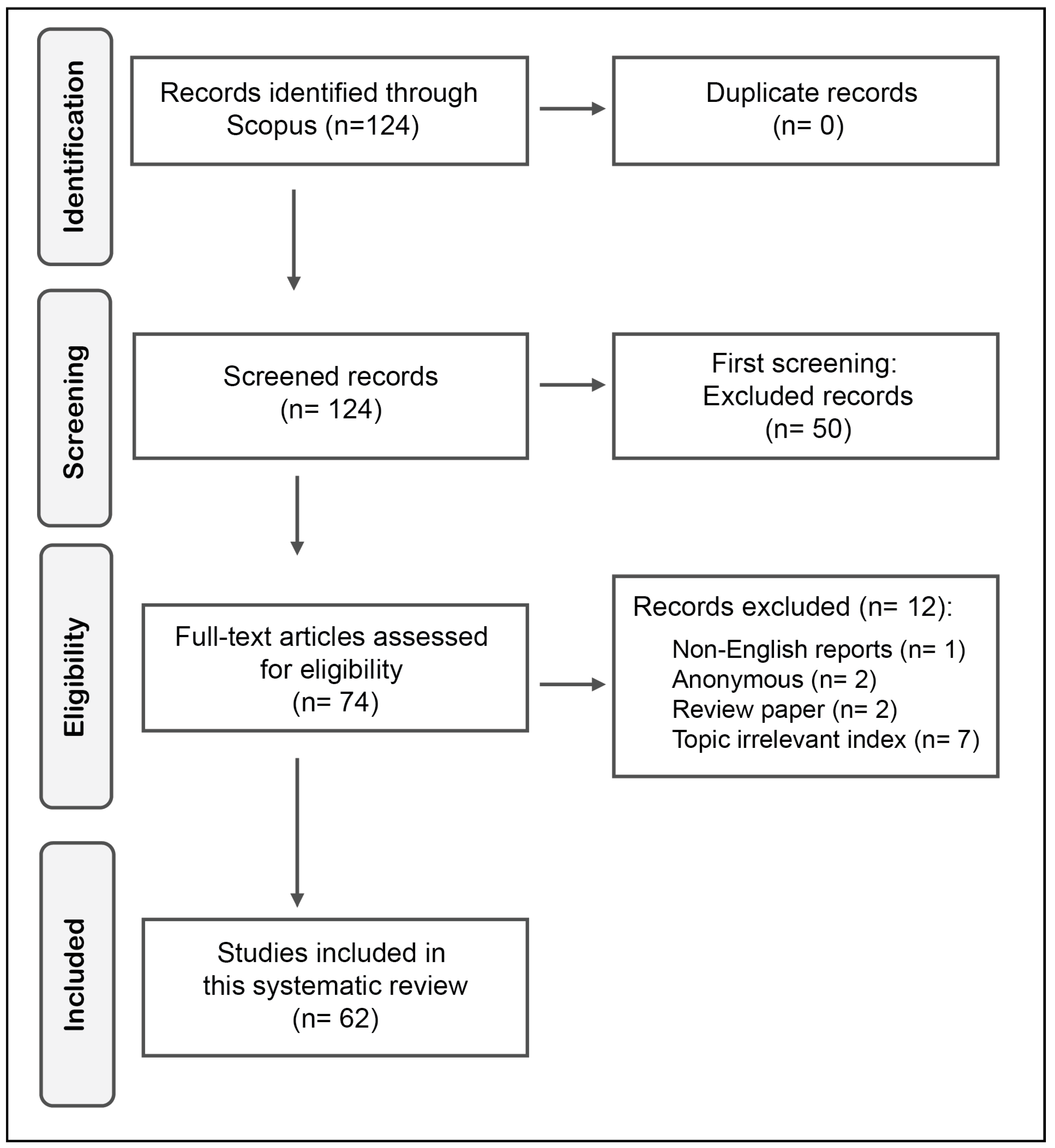

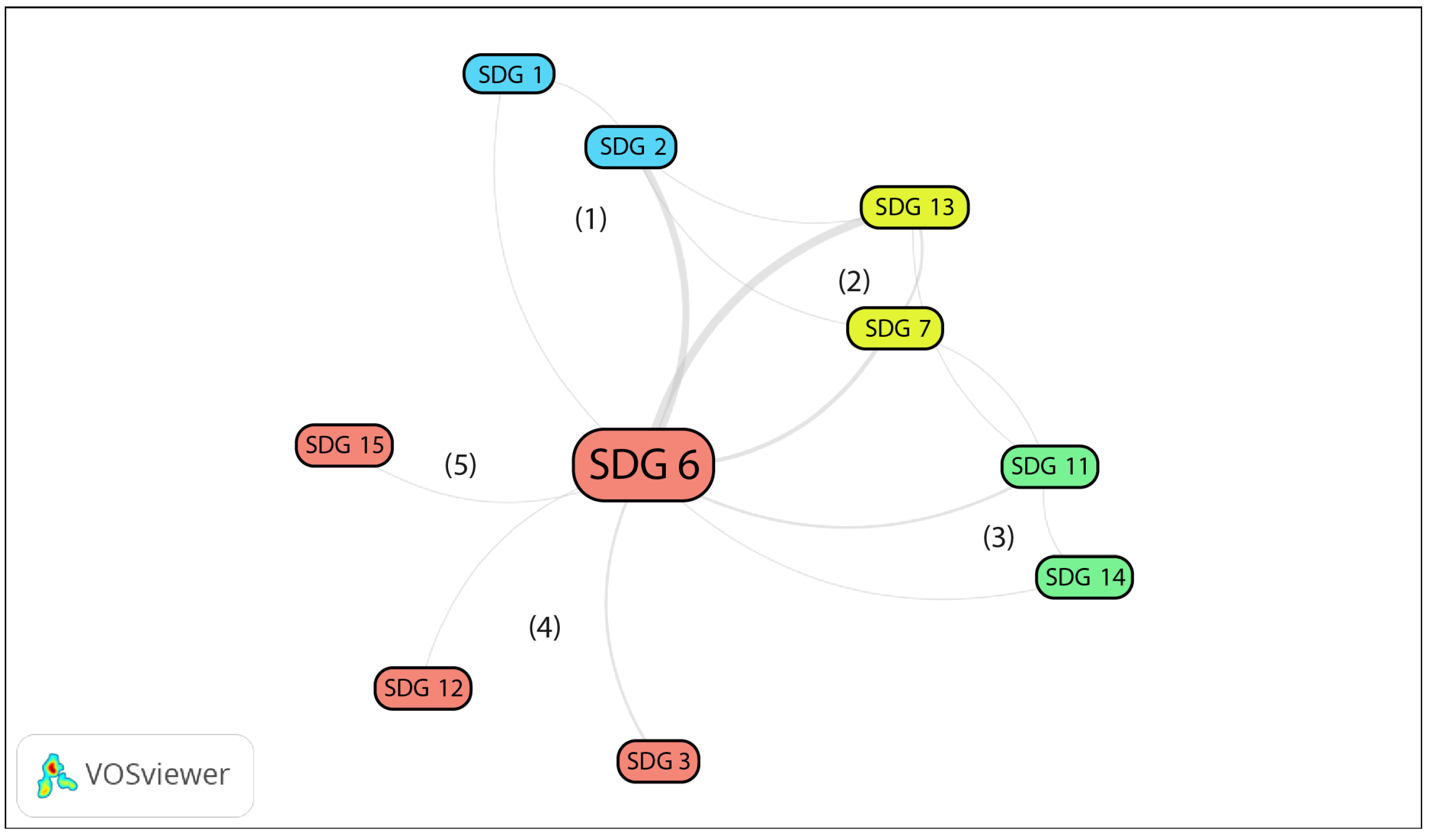
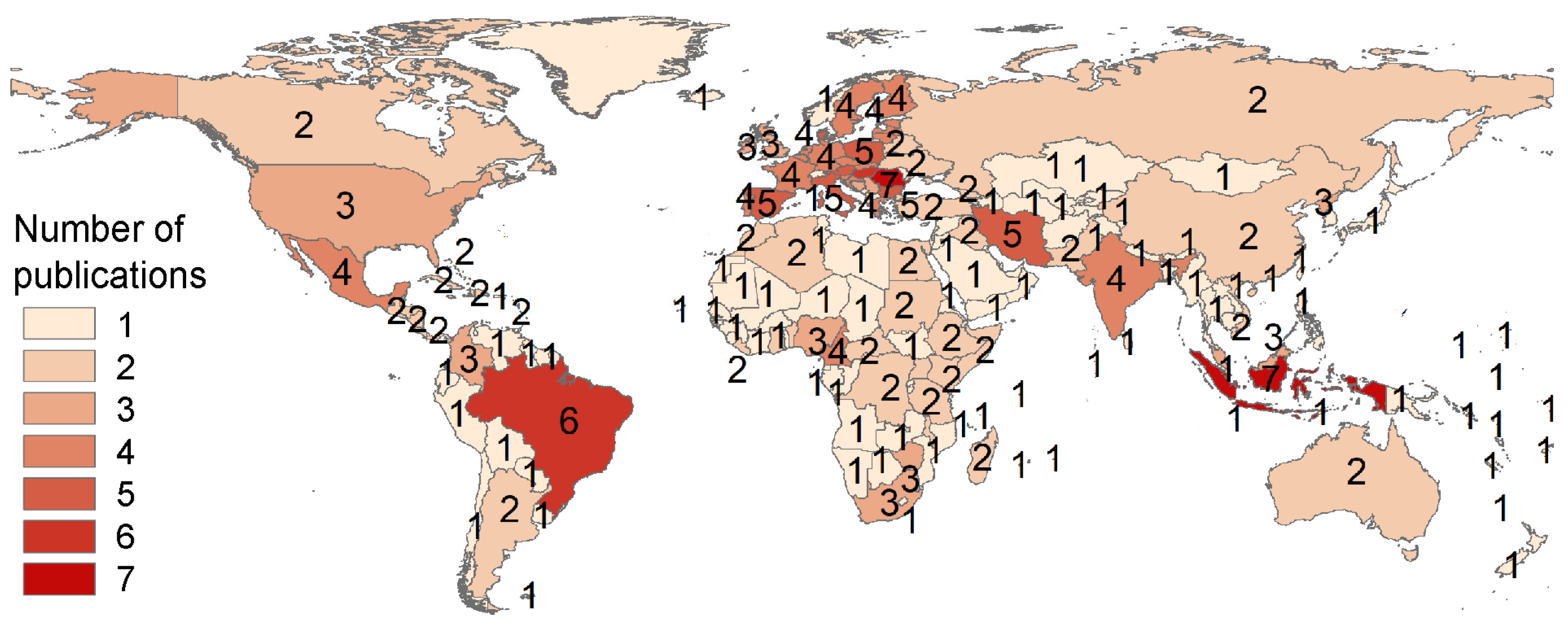



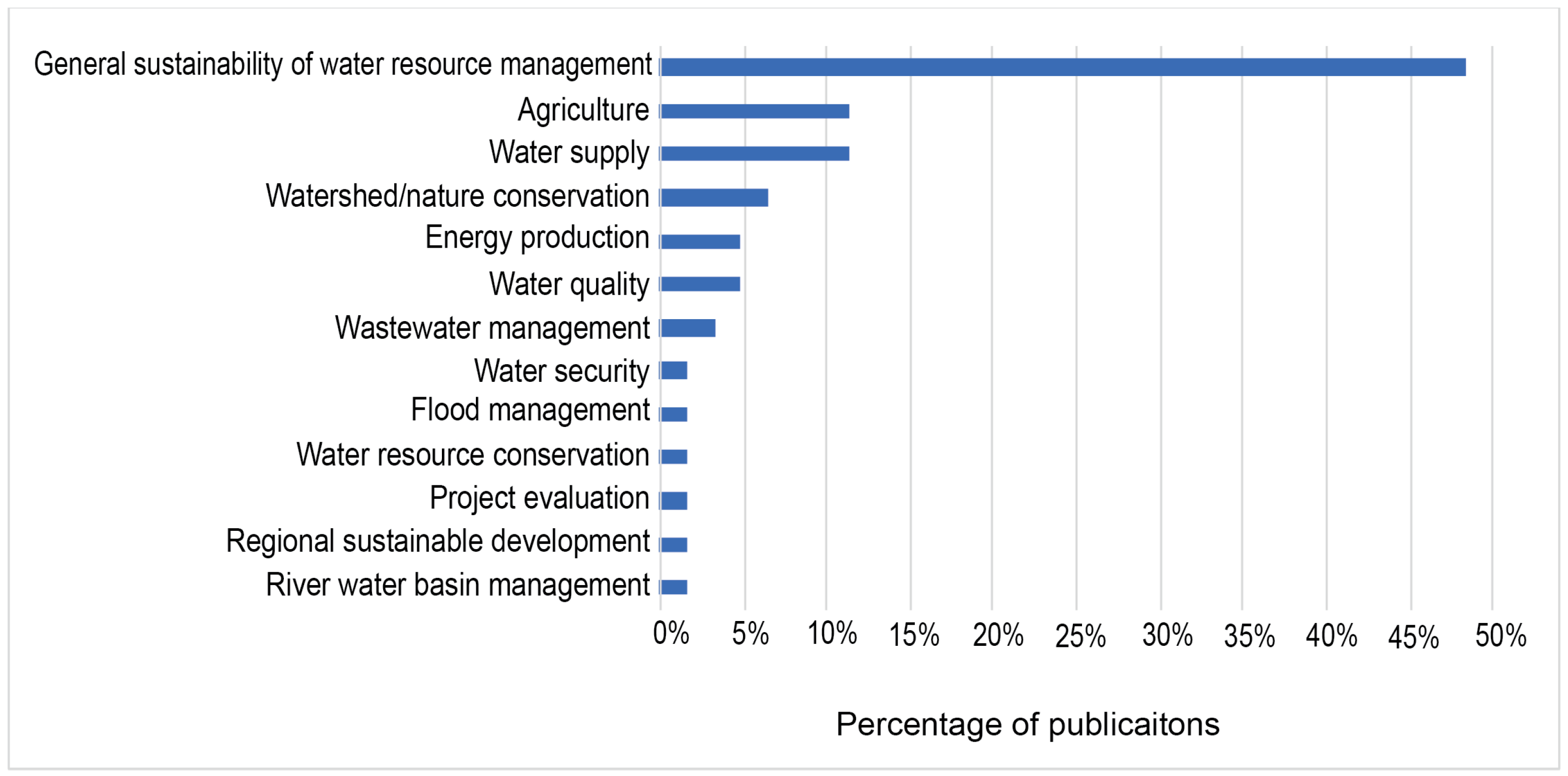
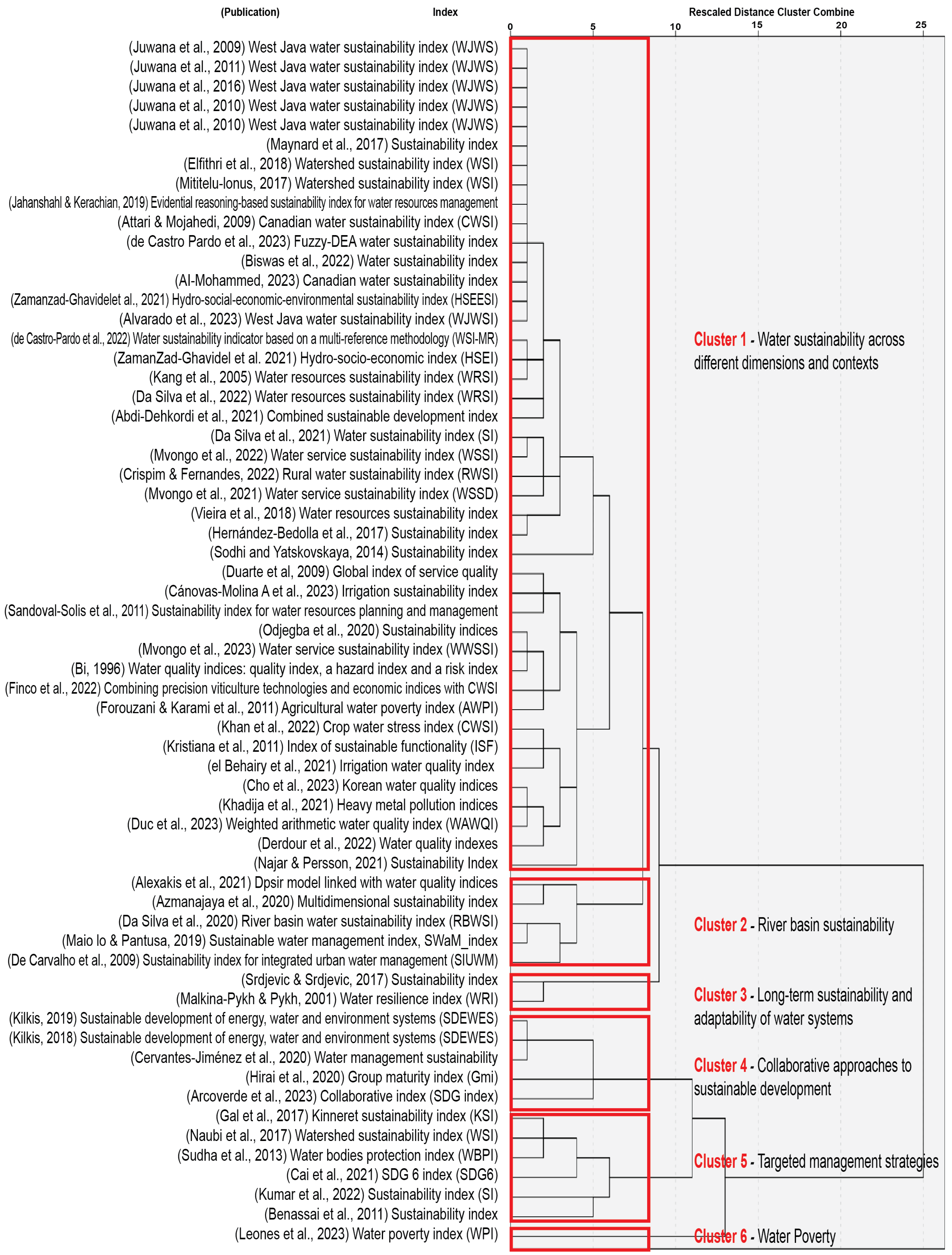
| Variable | Value | Explanation |
|---|---|---|
| 1. Addressed SDGs (directly and indirectly) | 1 = SDG 1: No poverty, 2 = SDG 2: zero hunger, 3 = SDG 3: good health and well-being, 4 = SDG 4: quality education, 5 = SDG 5: gender equality, 6 = SDG 6: clean water and sanitation, 7 = SDG 7: affordable and clean energy, 8 = SDG 8: decent work and economic growth, 9 = SDG 9: industry, innovation, and infrastructure, 10 = SDG 10: reduced inequality, 11 = SDG 11: sustainable cities and communities, 12 = SDG 12: responsible consumption and production, 13 = SDG 13: climate action, 14 = SDG 14: life below water, 15 = SDG 15: life on land, 16 = SDG 16: peace, justice, and strong institutions, 17 = SDG 17: partnerships for the goals). Multiple goals can be listed. | Categorizing the index’s role in the realization of sustainable development goals, including water-related goals (SDG 6 and 14). |
| 2. Input data time frame | 1 = Historical, 2 = historical to present, 3 = present, 4 = historical to future, 5 = current to future, 6 = future, 7 = dummy data | Referring to the specific duration or period over which the data are collected and analyzed. |
| 3. Input data domain | 1 = Social; 2 = institutional; 3 = economic; 4 = built/infrastructure; 5 = environmental | Its complexity explains the range of the variable and the index |
| 4. Water data as the input | 1 = Water quality, 2 = water quantity/availability (including moisture), 3 = water quality and quantity, 4 = no water-related parameters | Identifying the role of the water quality and quantity in computing the index. |
| 5. Number of variables (raw data or parameters) used as the input | 1 = 1–10, 2 = 11–20, 3 = 21–30, 4 = 31–40, 5 = 41–50, 6 = 51–60, 7 = 61 and above | Expressing the difficulty of obtaining a complete set of the data for the calculation. |
| 6. Data sources | 1 = Primary data, 2 = secondary data, 3 = primary and secondary data | Expressing the difficulty of data collection for computing the index. |
| 7. Geographical scale/area | 0 = Not specified, 1 = rural 2 = urban, 3 = regional/watershed, 4 = national, 5 = transboundary or global, 6 = institutional/business | Expressing the scale for which the index was designed or applied. |
| 8. Projecting future water sustainability | 1 = yes, 2 = no | Identifying if the index can elicit future results. |
| 9. Application of the indicator | 1 = General sustainability of water resource management; 2 = river water basin management; 3 = water supply; 4 = agriculture; 5 = wastewater management; 6 = water quality; 7 = regional sustainable development; 8 = project evaluation, 9 = water resource conservation; 10 = energy production, 11 = watershed/nature conservation; 12 = flood management; 13 = water security | Explains the application field or sector for which the index was designed or applied. |
| Cluster | Indices |
|---|---|
| 1 | 30 Publications, indices: agricultural water poverty index, Canadian water sustainability index, combined sustainable development index, combining precision viticulture technologies, crop water stress index, evidential reasoning-based sustainability index, fuzzy-DEA water sustainability index, global index of service quality, heavy metal pollution indices, hydro-socio-economic index, hydro-social-economic-environmental sustainability index, index of sustainable functionality, irrigation sustainability index, irrigation water quality index, Korean water quality indices, rural water sustainability index, sustainability index for water resources, sustainability index, water resources sustainability index, water service sustainability index, water sustainability index, watershed sustainability index, West Java water sustainability index; water quality indices: quality index, a hazard index, water service sustainability index, and weighted arithmetic water quality index. |
| 2 | 5 Publications, indices: river basin water sustainability index, sustainable water management index, water quality indices (with the DPSIR model), multidimensional sustainability index, and sustainability index for integrated urban water management. |
| 3 | 2 Publications, indices: sustainability index and water resilience index. |
| 4 | 5 Publications, indices: collaborative index (SDG index), group maturity index, sustainable development of energy, water, and environment systems, and water management sustainability index. |
| 5 | 6 Publications, indices: Kinneret sustainability index, sustainability index, water bodies protection index, watershed sustainability index, and SDG 6 index. |
| 6 | 1 Publication, index: water poverty index |
Disclaimer/Publisher’s Note: The statements, opinions and data contained in all publications are solely those of the individual author(s) and contributor(s) and not of MDPI and/or the editor(s). MDPI and/or the editor(s) disclaim responsibility for any injury to people or property resulting from any ideas, methods, instructions or products referred to in the content. |
© 2024 by the authors. Licensee MDPI, Basel, Switzerland. This article is an open access article distributed under the terms and conditions of the Creative Commons Attribution (CC BY) license (https://creativecommons.org/licenses/by/4.0/).
Share and Cite
Jarzebski, M.P.; Karthe, D.; Chapagain, S.K.; Setiawati, M.D.; Wadumestrige Dona, C.G.; Pu, J.; Fukushi, K. Comparative Analysis of Water Sustainability Indices: A Systematic Review. Water 2024, 16, 961. https://doi.org/10.3390/w16070961
Jarzebski MP, Karthe D, Chapagain SK, Setiawati MD, Wadumestrige Dona CG, Pu J, Fukushi K. Comparative Analysis of Water Sustainability Indices: A Systematic Review. Water. 2024; 16(7):961. https://doi.org/10.3390/w16070961
Chicago/Turabian StyleJarzebski, Marcin Pawel, Daniel Karthe, Saroj Kumar Chapagain, Martiwi Diah Setiawati, Chethika Gunasiri Wadumestrige Dona, Jian Pu, and Kensuke Fukushi. 2024. "Comparative Analysis of Water Sustainability Indices: A Systematic Review" Water 16, no. 7: 961. https://doi.org/10.3390/w16070961
APA StyleJarzebski, M. P., Karthe, D., Chapagain, S. K., Setiawati, M. D., Wadumestrige Dona, C. G., Pu, J., & Fukushi, K. (2024). Comparative Analysis of Water Sustainability Indices: A Systematic Review. Water, 16(7), 961. https://doi.org/10.3390/w16070961






